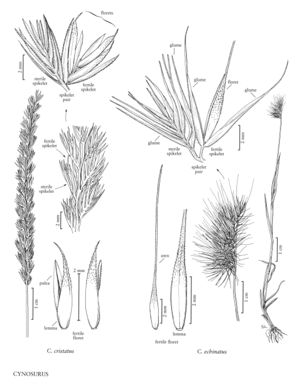Difference between revisions of "Cynosurus echinatus"
FNA>Volume Importer |
FNA>Volume Importer |
(No difference)
| |
Revision as of 19:17, 24 September 2019
Plants annual; tufted. Culms 9-70 cm, clustered or solitary. Sheaths smooth, glabrous; ligules 2.5-5(10) mm, obtuse, entire; blades 3-13.5(23) cm long, 2.5-14 mm wide, scab¬rous. Panicles 1-4(8) cm long, 0.7-2 cm wide, ovoid to almost globose, unilateral. Spikelets 7-14 mm, subsessile or shortly pedicellate; pedicels to 1.6 mm. Sterile spikelets with 6-18 florets; glumes and lemmas similar, subulate to linear-lanceolate, glabrous, sometimes scabridulous, awned, awns to 8 mm. Fertile spikelets with 1-5 florets, glumes and lemmas dissimilar; glumes 5.5-12 mm long, 0.4-0.9 mm wide, narrowly lanceolate, laterally compressed, hyaline, glabrous, 1-veined, keeled, awned, awns 0.5-2.2 mm; rachilla internodes 0.9-1.3 mm; lemmas 4-7 mm, slightly dorsally compressed, chartaceous or coriaceous, not keeled, lower 1/2 smooth, glabrous, distal 1/2 villous or scabrous, apices hyaline, ciliolate, entire or bidentate, awned, awns 5-18(25) mm; anthers 1-4 mm. 2n = 14.
Distribution
Wash., B.C., W.Va., N.J., N.Mex., Tex., La., N.C., S.C., Tenn., N.Y., Pa., Va., Calif., Ala., Ark., Ga., Conn., Md., Okla., Ohio, Mo., Mich., Mont., Miss., Oreg.
Discussion
Cynosurus echinatus is native to southern Europe. It is now established in dry, open habitats in North America, South America, and Australia.
Selected References
None.
